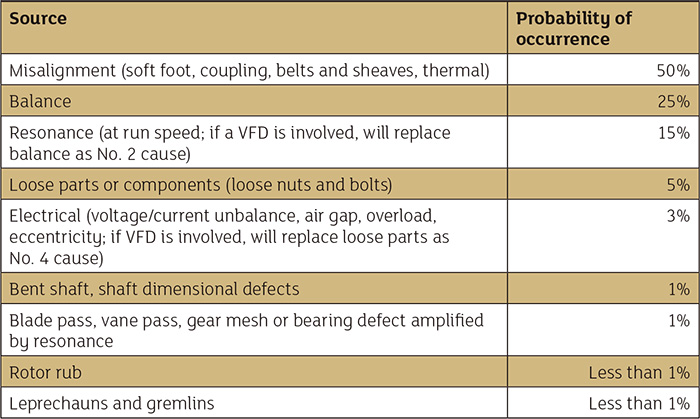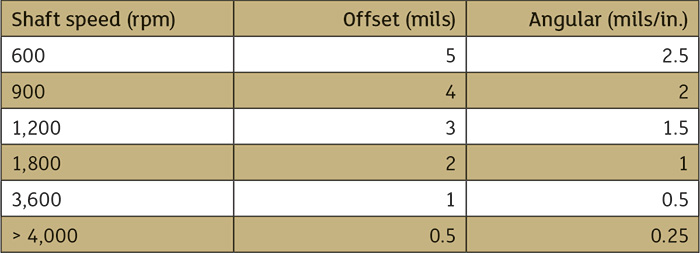In my last article, “Understanding Available Technology Is Necessary for Successful Vibration Monitoring” (Pumps & Systems, July 2016, read it here), I might have left you hanging. Yes, there is a cost benefit to starting with an analog-based vibration monitoring program, but what do you lose when a digital device has the potential to do more? A digital vibration analyzer that provides visual indication of both time domain (alternating-current [AC] signal) and frequency domain (spectrum of contributing frequencies) is a valuable tool for any facility. If you have a technician who can actually use the device to its full capability, then you have a winning combination. Without an analyzer or a competent technician, troubleshooting vibration problems can be difficult. The sales team often insists that you need the best, most advanced spectrum analyzer to monitor and troubleshoot—but is that true? Based on experience, I know that if I go into a facility with no knowledge of previous work and collect simple analog low-frequency vibration data (filter out root mean square [RMS] value), I typically find 15 to 20 percent of similar equipment types on the high side of an established normal vibration level. Of that 15 to 20 percent, up to 5 percent of that equipment has serious issues. If I were to supplement the low-frequency data collected with a round of high-frequency data, I would typically find less than 5 percent of similar equipment types with indications of potential bearing issues. The more serious vibration issues—those that result in shutdown—are usually caused by design misapplication or installation errors. These issues are hard to troubleshoot and even harder to repair. Once identified, however, they generally require a one-time fix.
 Table 1. Common vibration sources (Graphics courtesy of the author)
Table 1. Common vibration sources (Graphics courtesy of the author)Real-World Troubleshooting
To apply the above statistics, consider the following example. If I had 60 small-frame (American National Standards Institute [ANSI] frame) pumps, all between 60 and 100 horsepower (hp), and 20 percent exhibit higher than normal values (alarm status), then I have 12 pumps on my watch list. Five percent of those pumps, or one pump, would exhibit vibration readings that would warrant a shutdown status. Plus, I would have two additional pumps that indicate a potential bearing issue. Of the two pumps with potential bearing issues, one or both pumps likely would be in the group of 12 watch-list pumps. For this discussion, we will assume that there are two additional pumps that need attention. That means I have one pump out of 60 that requires immediate attention and 13 that should be placed on a watch list. Of the 13, two have a bearing issue and 11 have another issue. Do I need to spend money on a spectrum analyzer to troubleshoot my one shutdown pump? Probably not. Between the cost of the analyzer and the training to use it, I could buy and install a new pump, maybe even two. Keep in mind that the vibration issue on my one shutdown pump is probably a one-time fix. Table 2. Alignment tolerances for small-frame pumps that are electrical-motor-driven
Table 2. Alignment tolerances for small-frame pumps that are electrical-motor-drivenCommon Causes of Vibration
If you have been in this business long enough, especially over the last 20 years, you have probably read everything there is to read regarding vibration troubleshooting. The internet is rich with comments, videos and technical articles that focus on vibration monitoring. One item that will pop up every now and then is a chart that shows the most common causes of equipment vibration. I have developed my own variation based on my experience in power production, U.S. Department of Energy (DOE) nuclear remediation projects and manufacturing segments. Unlike many sources, my top cause is alignment, not balance (see Table 1). For the remaining 11 watch-list pumps, I will schedule things I have immediate control over or can self-perform—things that are in the top 10 vibration causes. I will check mounting bolt tightness, electrical components (balanced current/voltage between phases) and the structure (resilient mounts, cracks and breaks). I will also schedule precision-alignment checks. Precision alignment is establishing and documenting a measurable tolerance (acceptance criteria) for flexibly coupled equipment based on equipment speed. The most important part is meeting that criteria when completing the alignment. Now I not only have performance criteria for my dynamic equipment (vibration monitoring), but I also have acceptance criteria that allows me to meet that performance criteria (see Table 2). These tolerances are based on the reverse dial indicator method of alignment. All commercial laser alignment sets on the market today are based on this method of alignment. What if your facility does not have the skills or equipment to perform this type of alignment? You can use your established and documented precision alignment acceptance criteria to establish vendor contract requirements. To double check the vendor’s work, I now have established low- and high-frequency vibration performance criteria and can use that criteria to ensure the vendor’s alignments are effective based on post-maintenance acceptance testing. Based on my 30-plus years of experience in the industry, checking nuts and bolts, correcting any electrical issues (balanced current/voltage), verifying structural integrity and verifying alignment will bring 75 percent of your watch-list pumps into an acceptable dynamic (vibration) performance range. Now we have just two remaining watch-list pumps. For these, the cause of vibration may be a bit more difficult to identify and correct. Based on our probability chart, there is a good chance of a mechanical balancing issue. If a variable frequency drive (VFD) is involved, there may be a resonance issue. Now it is time to call an expert consultant to provide support for your maintenance staff. Just remember to establish criteria in the contract for the consultant to work against. Make it clear that he or she only gets paid if there is an improvement. Using reason, logic, common sense and world-class business practices, leveraging access to global media as a tool to determine the most probable causes of dynamic equipment degraded performance, establishing specific performance criteria and determining specific acceptance criteria will help me improve the dynamic condition of my 60 small-frame pumps without investing in a spectrum analyzer and the required training. I am left with the advantage of a validated and ongoing condition-based maintenance (CBM) program at the best price.Added Value
The last step in this process is to document the improvement and show the value added by the improved performance of my 14 small-frame pumps. Do not expect to see a complete payback for your monitoring equipment, training and program investment. However, showing small gains from this one specific equipment type can improve your credibility with CBM program investment. The easiest way to show added value for common equipment types, such as pumps and fans, is to show deferred overhaul (rebuild) schedule—from a three-year overhaul cycle to a four-year overhaul cycle, showing the cost deferment over a 10-year period. So instead of three overhauls in 10 years, you now have two. And, if luck is on your side, one of your 14 deficient pumps will be a business-critical pump. Here you could model the cost savings through an avoided unscheduled outage—a $5,000 investment just saved you $1 million in production losses. Editor’s Note: This article is part of an ongoing series by the author covering topics related to predictive maintenance.Alignment Methods
Many users do not know or understand the reverse dial indicator method of alignment. The following resources discuss different alignment methods, show when they are applicable and provide instructions on how to complete each one.
ludeca.com/brochures/Ludeca_A-Practical-Guide-to-Shaft-Alignment.pdf
lifetime-reliability.com/tutorials/maintenance-management/18_ShaftAlignment.pdf
reliabilityweb.com/index.php/articles/rim_face_alignment_method/

